CHEVROLET ASTRO 1997 2.G Owners Manual
Manufacturer: CHEVROLET, Model Year: 1997, Model line: ASTRO, Model: CHEVROLET ASTRO 1997 2.GPages: 404, PDF Size: 20.63 MB
Page 321 of 404
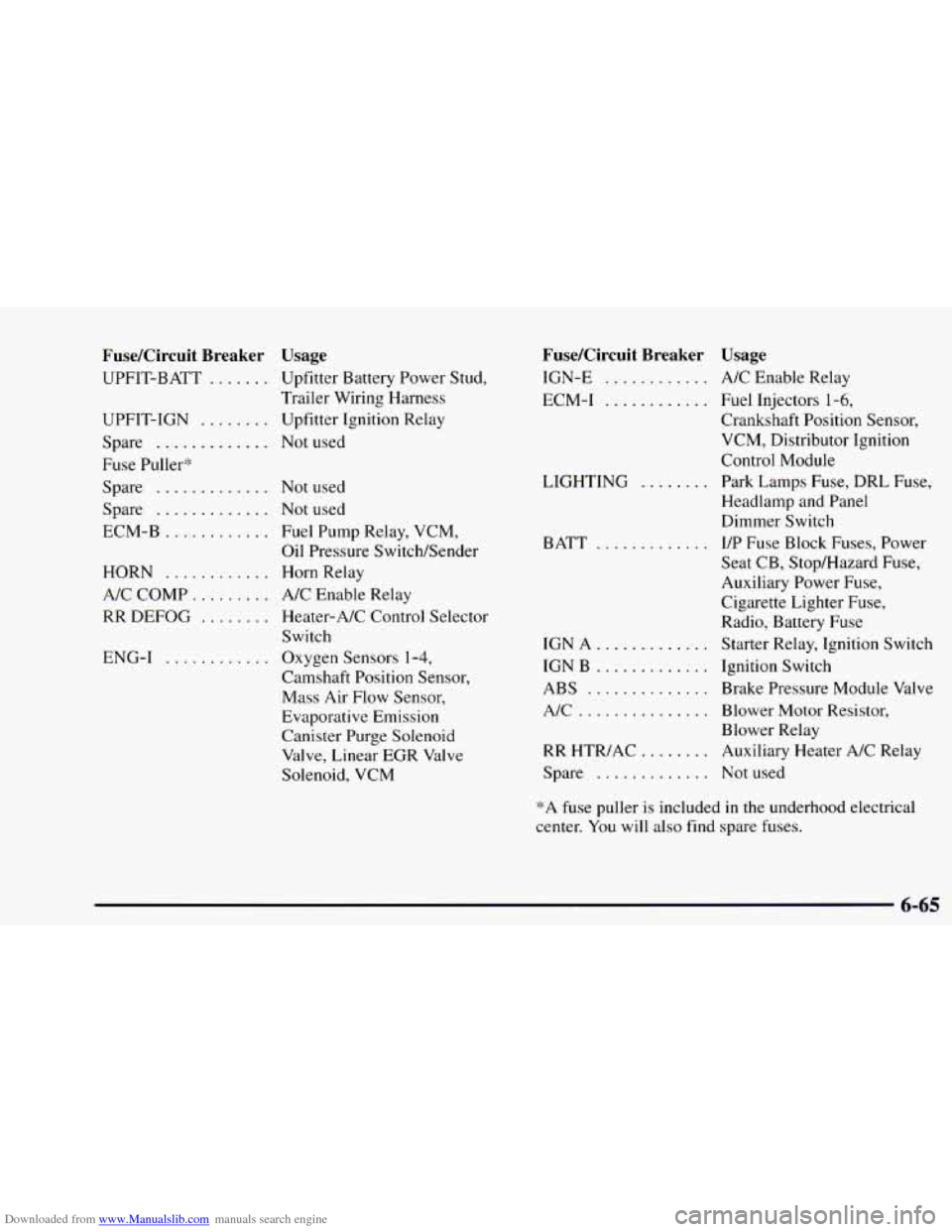
Downloaded from www.Manualslib.com manuals search engine FuseKircuit Breaker
UPFIT-BATT .......
UPFIT-IGN ........
Spare .............
Fuse Puller*
Spare
.............
Spare .............
ECM-B ............
HORN ............
A/C COMP .........
RR DEFOG ........
ENG-I ............
Usage
Upfitter Battery Power Stud,
Trailer Wiring Harness
Upfitter Ignition Relay
Not used
Not used
Not used
Fuel Pump Relay, VCM,
Oil Pressure Switch/Sender
Horn Relay
A/C Enable Relay
Heater-A/C Control Selector
Switch
Oxygen Sensors
1-4,
Camshaft Position Sensor,
Mass Air Flow Sensor,
Evaporative Emission
Canister Purge Solenoid
Valve, Linear EGR Valve
Solenoid,
VCM
FuseKircuit Breaker
IGN-E ............
ECM-I ......... ~.
LIGHTING ........
BATT .............
IGNA .............
IGN B .............
ABS ..............
A/C ...............
RR HTR/AC ........
Spare .............
Usage
A/C Enable Relay
Fuel Injectors 1-6,
Crankshaft Position Sensor,
VCM, Distributor Ignition
Control Module
Park Lamps Fuse, DRL Fuse,
Headlamp and Panel
Dimmer Switch
I/P Fuse Block Fuses, Power
Seat CB, Stop/Hazard Fuse,
Auxiliary Power Fuse,
Cigarette Lighter Fuse,
Radio, Battery Fuse
Starter Relay, Ignition Switch
Ignition Switch Brake Pressure Module Valve
Blower Motor Resistor,
Blower Relay Auxiliary Heater
A/C Relay
Not used
*A fuse puller is included in the underhood electrical
center.
You will also find spare fuses.
6-65
Page 322 of 404
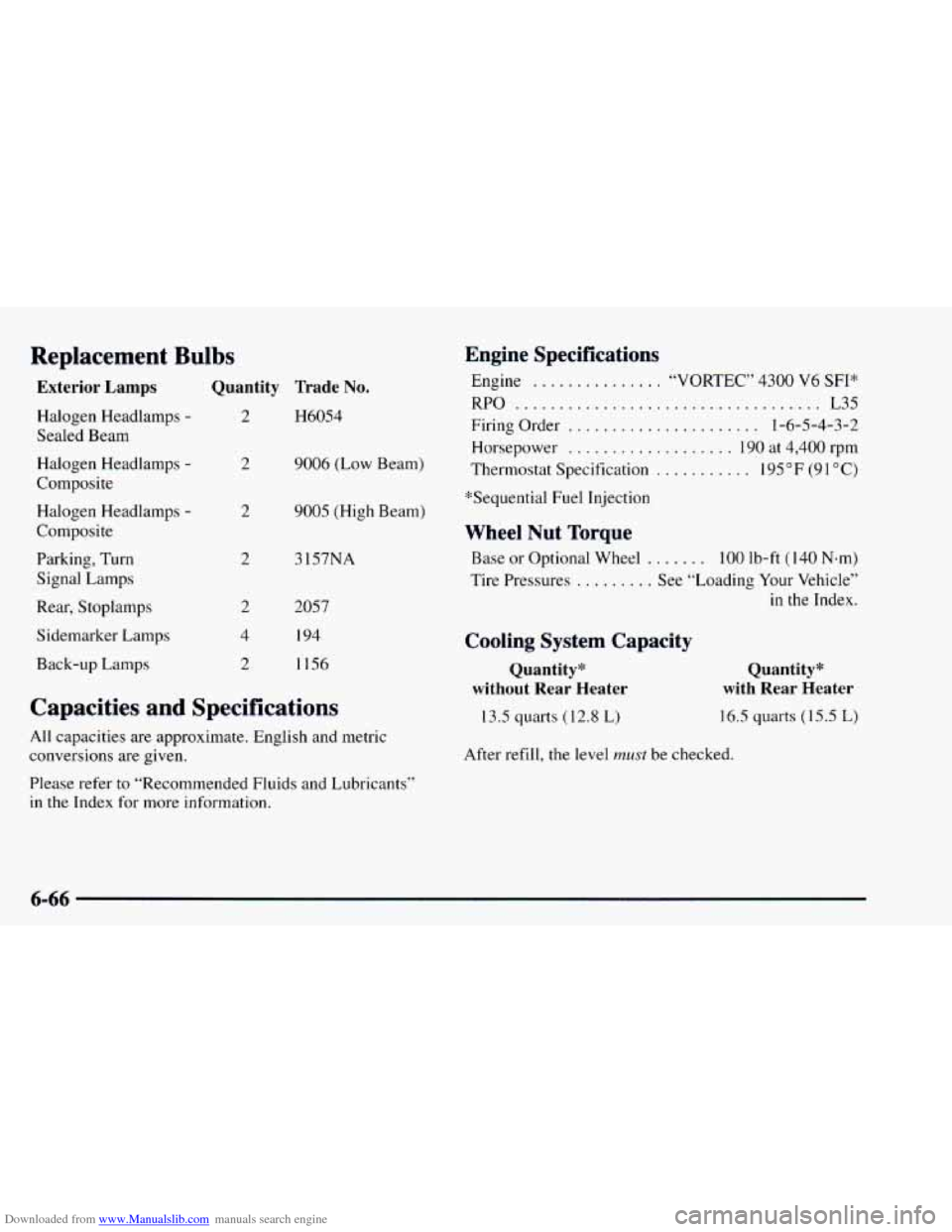
Downloaded from www.Manualslib.com manuals search engine Replacement Bulbs
Exterior Lamps Quantity Trade No.
Halogen Headlamps - 2 H6054
Sealed Beam
Halogen Headlamps
-
Composite
2 9006 (Low Beam)
Halogen Headlamps
-
Composite Parking, Turn
Signal Lamps
Rear, Stoplamps
Sidemarker Lamps
Back-up Lamps 2
2
2
4
2
9005 (High Beam)
3 157NA
2057
194
1156
Capacities and Specifications
All capacities are approximate. English and metric
conversions are given.
Please refer to “Recommended Fluids and Lubricants”
in the Index for more information.
Engine Specifications
Engine ............... “VORTEC” 4300 V6 SFI*
RPO ................................... L35
Firing Order ...................... 1-6-5-4-3-2
Horsepower
................... 190 at 4,400 rpm
Thermostat Specification
........... 195 “F (9 1 “C)
*Sequential Fuel Injection
Wheel Nut Torque
Base or Optional Wheel ....... 100 lb-ft (140 N-m)
Tire Pressures
......... See “Loading Your Vehicle”
in the Index.
Cooling System Capacity
Quantity”
without Rear Heater
13.5 quarts (12.8 L)
Quantity*
with Rear Heater
16.5 quarts (15.5 L)
After refill, the level
must be checked.
6-66
Page 323 of 404
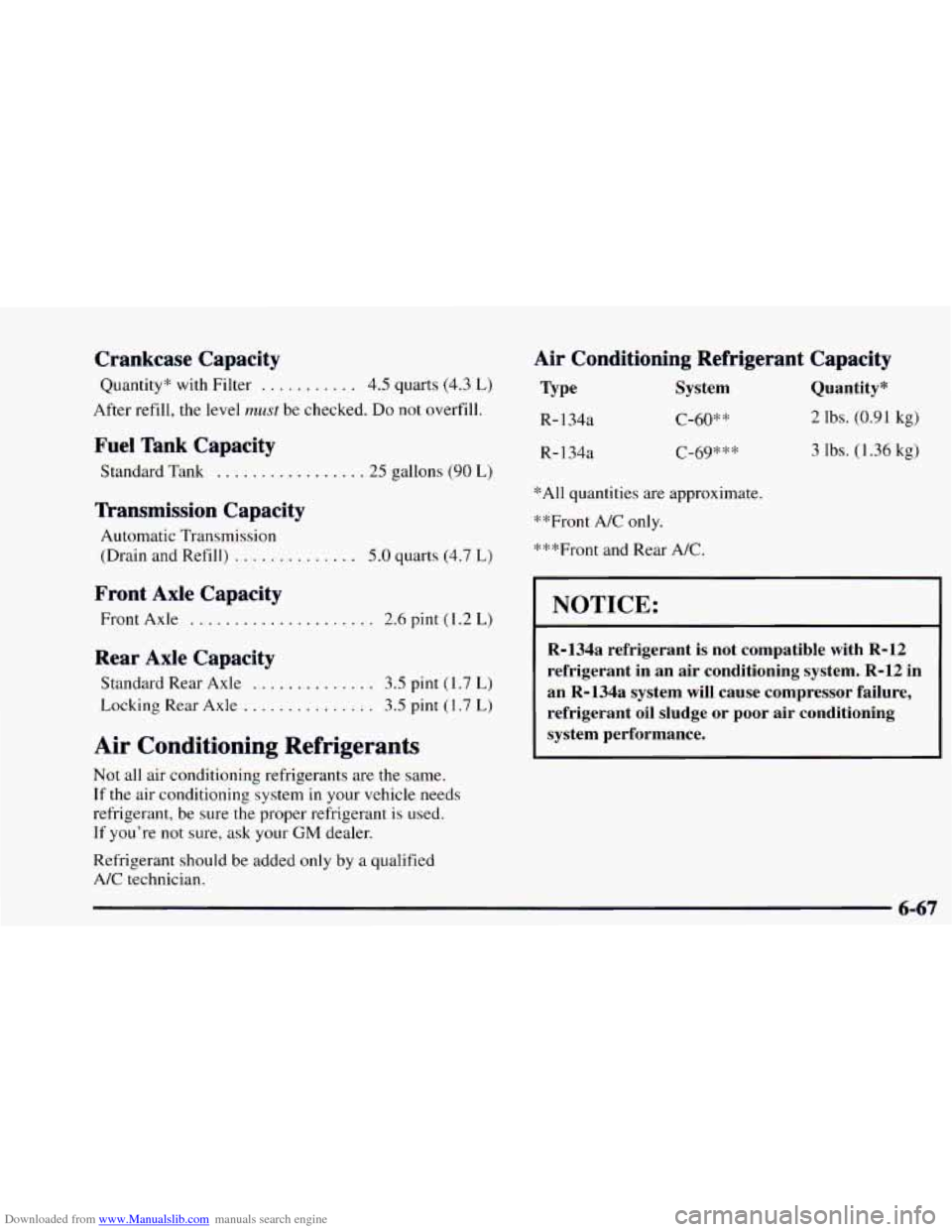
Downloaded from www.Manualslib.com manuals search engine Crankcase Capacity
Quantity* with Filter ........... 4.5 quarts (4.3 L)
After refill, the level must be checked. Do not overfill.
Fuel Tank Capacity
Standard Tank ................. 25 gallons (90 L)
Transmission Capacity
Automatic Transmission
(Drain and Refill)
.......... 5.0 quarts (4.7 L)
Front Axle Capacity
Front Axle .............. ... 2.6 pint (1.2 L)
Rear Axle Capacity
Standard Rear Axle .............. 3.5 pint (1.7 L)
Locking Rear Axle ............... 3.5 pint (1.7 L)
Air Conditioning Refrigerants
Not all air conditioning refrigerants are the same.
If the air conditioning system in your vehicle needs
refrigerant, be sure
the proper refrigerant is used.
If you’re not sure,
ask your GM dealer.
Refrigerant should be added only by a qualified
A/C technician.
Air Conditioning Refrigerant Capacity
Type System Quantity*
R- 134a C-60** 2 Ibs. (0.91 kg)
R- 134a C-(j9*** 3 lbs. (1.36 kg)
*All quantities are approximate.
**Front A/C only.
***Front and Rear A/C.
I NOTICE:
I
R-134a refrigerant is not compatible with R-12
refrigerant in an air conditioning system. R-12 in
an R-134a system
will cause compressor failure,
refrigerant oil sludge or poor air conditioning
system performance.
6-67
Page 324 of 404
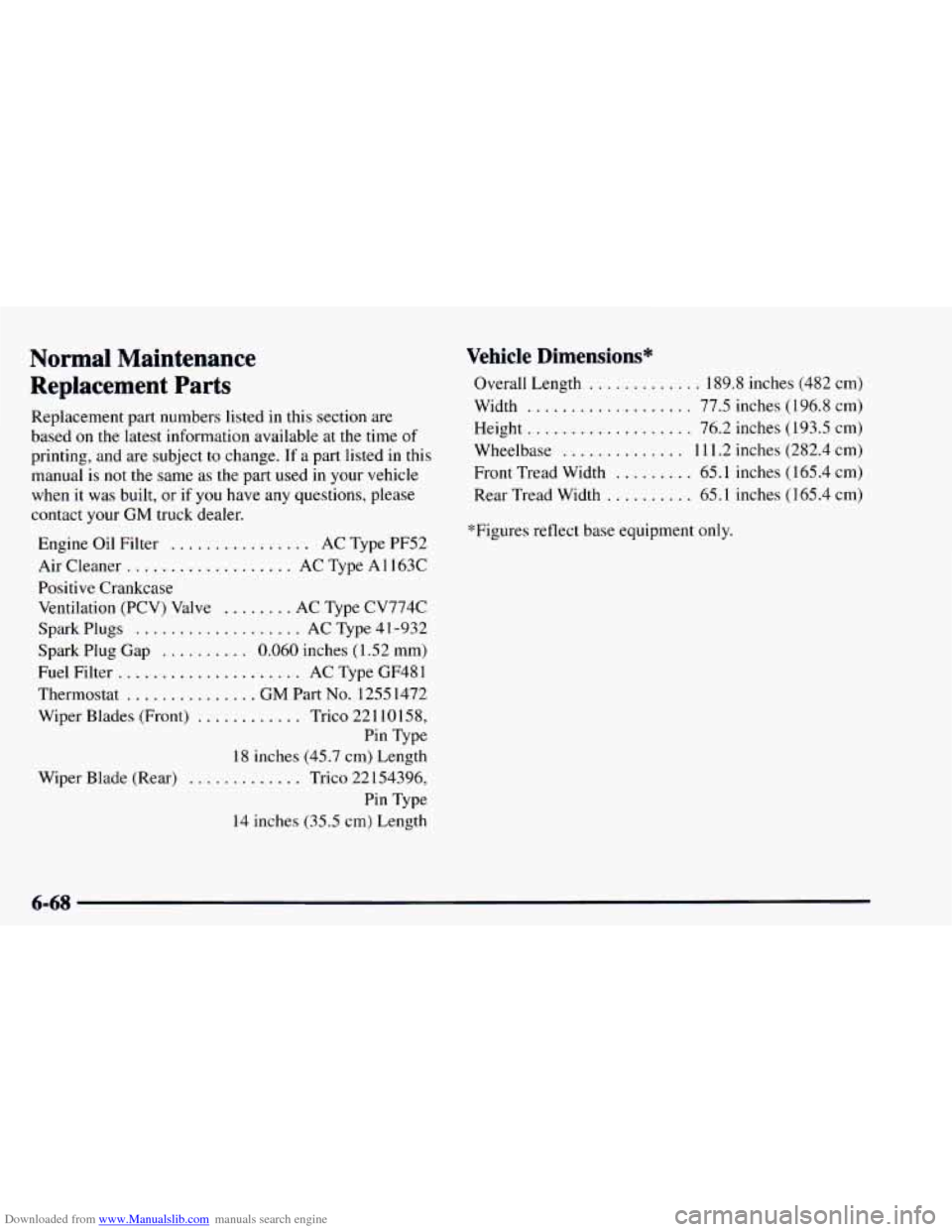
Downloaded from www.Manualslib.com manuals search engine Normal Maintenance
Replacement Parts
Replacement part numbers listed in this section are
based
on the latest information available at the time of
printing, and are subject to change. If a part listed in this
manual
is not the same as the part used in your vehicle
when it was built, or if you have any questions, please
contact your
GM truck dealer.
Engine Oil Filter
................ AC Type PF52
Air Cleaner
................... AC Type A 1 163C
Positive Crankcase
Ventilation (PCV) Valve
........ AC Type CV774C
Spark Plugs
................... AC Type 4 1-932
Spark Plug Gap
.......... 0.060 inches ( 1.52 mm)
Fuel Filter ..................... AC Type GF48 1
Thermostat
............... GM Part No. 1255 1472
Wiper Blades (Front)
............ Trico 221 10158, Pin Type
18 inches (45.7 cm) Length
Wiper Blade (Rear)
............. Trico 22 154396,
Pin Type
14 inches (35.5 cm) Length
Vehicle Dimensions*
Overall Length ............. 189.8 inches (482 cm)
Width
................... 77.5 inches (196.8 cm)
Height.
.................. 76.2 inches (193.5 cm)
Wheelbase
.............. 1 1 1.2 inches (282.4 cm)
Front Tread Width
......... 65.1 inches (165.4 cm)
Rear Tread Width
.......... 65.1 inches ( 1 65.4 cm)
*Figures reflect base equipment
only.
6-68
Page 325 of 404
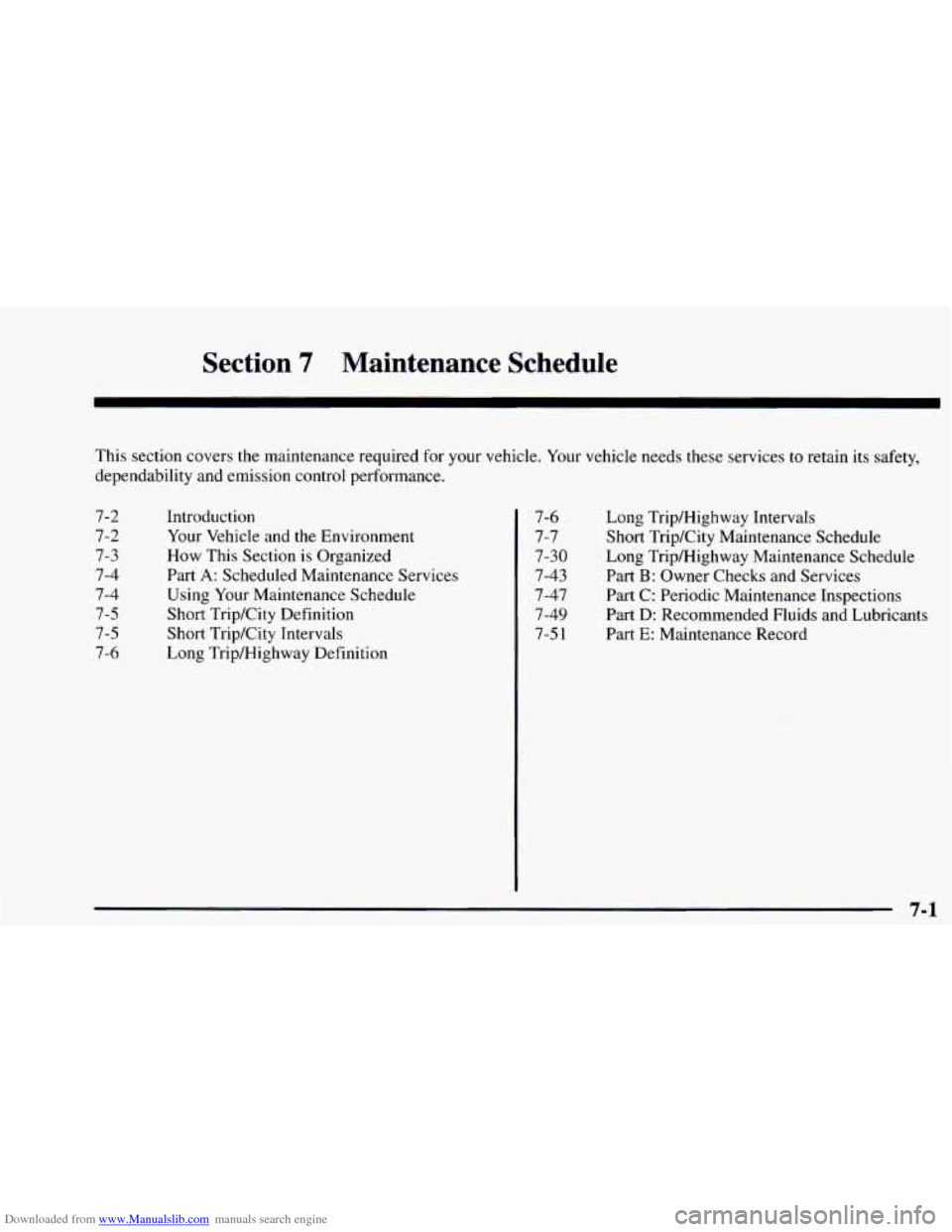
Downloaded from www.Manualslib.com manuals search engine Section 7 Maintenance Schedule
This section covers the maintenance required for your vehicle. Your vehicle needs these services to retain its safety,
dependability and emission control performance.
7-2
7-2
7-3
7-4
7-4
7-5 7-5
7-6 Introduction
Your
Vehicle and the Environment
How This Section is Organized
Part
A: Scheduled Maintenance Services
Using Your Maintenance Schedule
Short Trip/City Definition
Short Trip/City Intervals
Long Trip/Highway Definition 7-6
7-7
7-30
7-43
7-47
7-49
7-5
1
Long TripIHighway Intervals
Short Trip/City Maintenance Schedule
Long Trip/Highway Maintenance Schedule
Part
B: Owner Checks and Services
Part
C: Periodic Maintenance Inspections
Part
D: Recommended Fluids and Lubricants
Part
E: Maintenance Record
7-1
Page 326 of 404
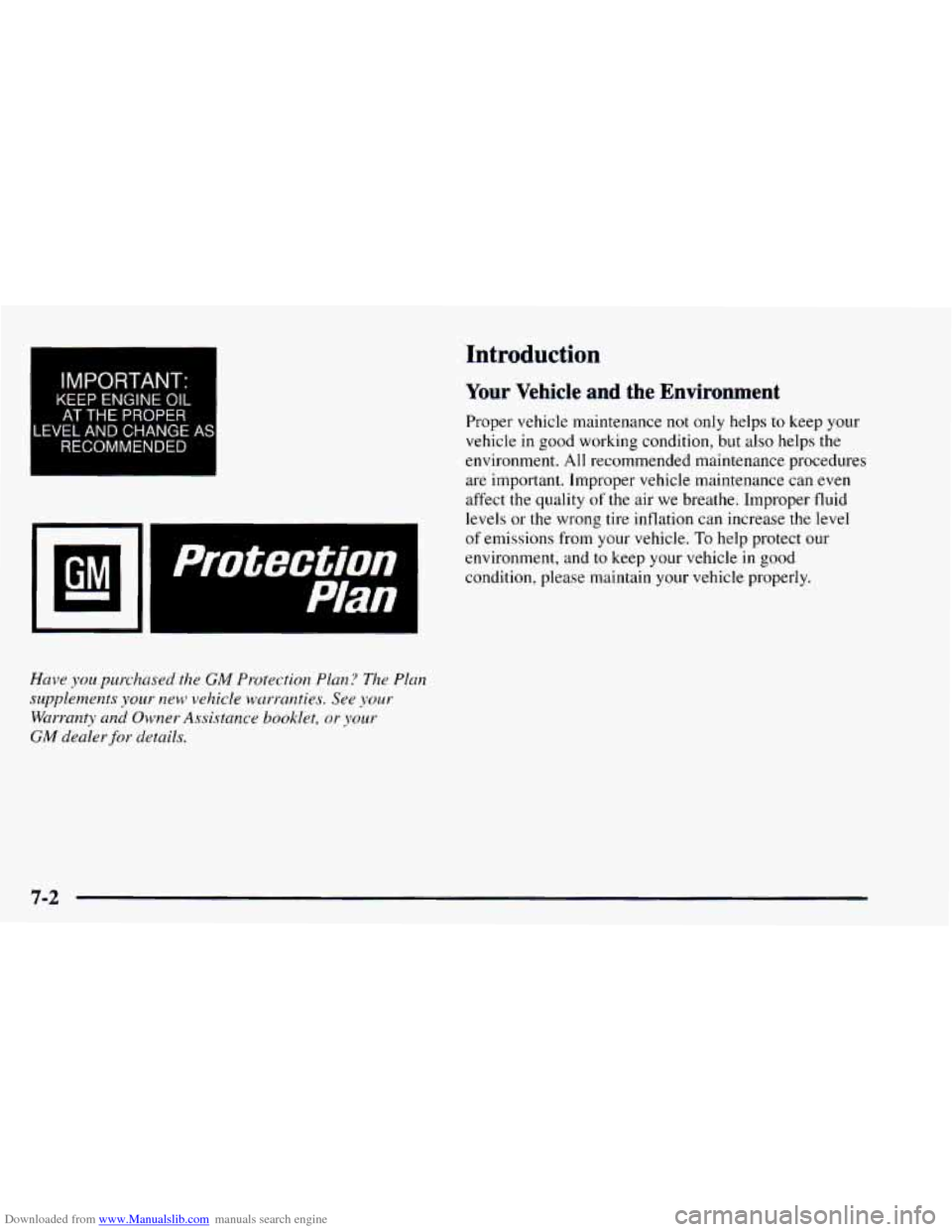
Downloaded from www.Manualslib.com manuals search engine Introduction
I IMPORTANT: I
KEEP ENGINE OIL
AT THE PROPER
LEVEL AND CHANGE AS
RECOMMENDED
I protection I
Plan
Have you purchcrsed the GM Protection Plcrn? The Plarz
supplements
your new vehicle warranties. See your
Warranty and Owner Assistance booklet, or your
GM dealer for details.
Your Vehicle and the Environment
Proper vehicle maintenance not only helps to keep your
vehicle in good working condition,
but also helps the
environment. All recommended maintenance procedures
are important. Improper vehicle maintenance can
even
affect the quality of the air we breathe. Improper fluid
levels or the wrong tire inflation can increase the level
of emissions from your vehicle. To help protect our
environment, and to keep
your vehicle in good
condition, please maintain your vehicle properly.
7-2
Page 327 of 404
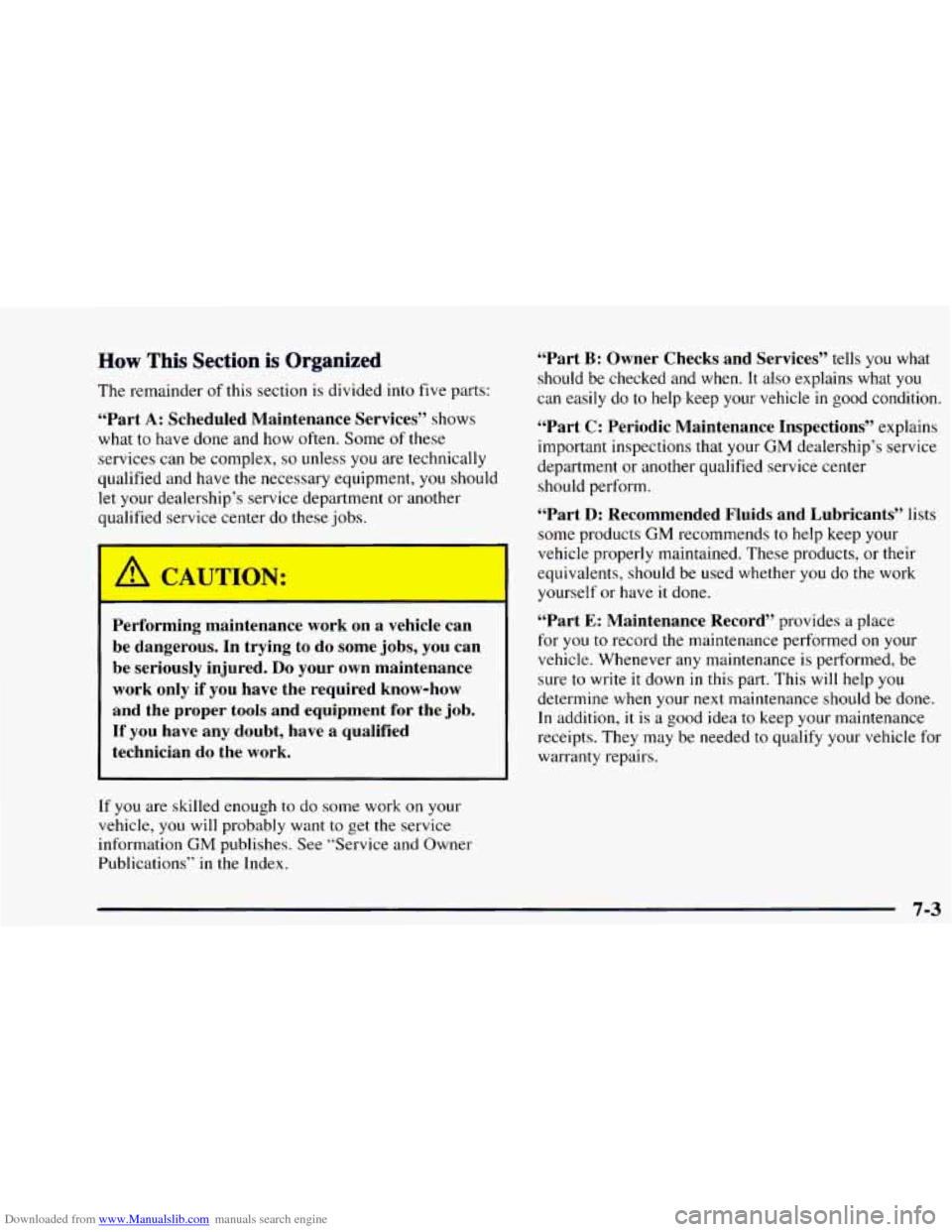
Downloaded from www.Manualslib.com manuals search engine How This Section is Organized
The remainder of this section is divided into five parts:
“Part A: Scheduled Maintenance Services” shows
what to have done and how often. Some
of these
services can be complex, so unless you are technically
qualified and have the necessary equipment,
you should
let your dealership’s service department or another
qualified service center do these jobs.
Performing maintenance work on a vehicle can
be dangerous. In trying to do some jobs,
you can
be seriously injured.
Do your own maintenance
work only if you have the required know-how
and the proper tools and equipment for the job.
If you have any doubt, have a qualified
technician
do the work.
If you are skilled enough to do some work on your
vehicle,
you will probably want to get the service
information
GM publishes. See “Service and Owner
Publications’‘
in the Index.
“Part B: Owner Checks and Services” tells you what
should be checked and when.
It also explains what you
can easily do to help keep your vehicle
in good condition.
“Part C: Periodic Maintenance Inspections” explains
important inspections that your
GM dealership’s service
department or another qualified service center
should perform.
“Part D: Recommended Fluids and Lubricants” lists
some products
GM recommends to help keep your
vehicle properly maintained. These products, or their
equivalents, should be used whether you do the work
yourself or have
it done.
“Part E: Maintenance Record” provides a place
for
you to record the maintenance performed on your
vehicle. Whenever any maintenance is performed, be
sure to write
it down in this part. This will help you
determine when your next maintenance should be done.
In addition, it is a good idea to keep your maintenance
receipts. They may be needed to qualify your vehicle for
warranty repairs.
7-3
Page 328 of 404
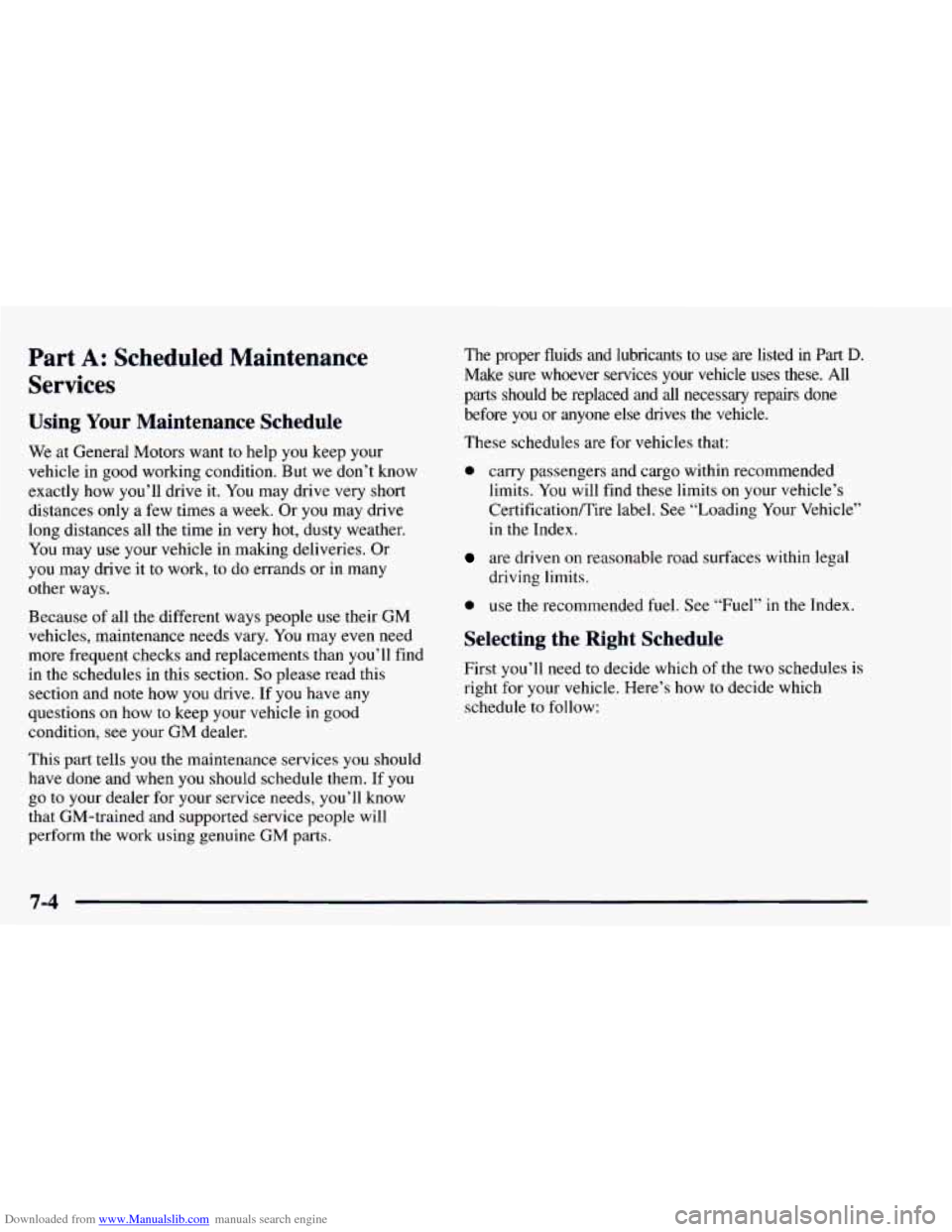
Downloaded from www.Manualslib.com manuals search engine Part A: Scheduled Maintenance
Services
Using Your Maintenance Schedule
We at General Motors want to help you keep your
vehicle in good working condition. But we don’t know
exactly how you’ll drive it.
You may drive very short
distances only a few times a week. Or
you may drive
long distances all the time in very hot, dusty weather.
You may
use your vehicle in making deliveries. Or
you may drive it
to work, to do errands or in many
other ways.
Because of all the different ways people use their
GM
vehicles, maintenance needs vary. You may even need
more frequent checks and replacements than
you’ll find
in the schedules in this section.
So please read this
section and note how you drive. If you have any
questions on how to keep your vehicle in good
condition,
see your GM dealer.
This part tells you the maintenance services
you should
have done and when
you should schedule them. If you
go to your dealer for your service needs, you’ll know
that GM-trained and supported service people will
perform
the work using genuine GM parts.
The proper fluids and lubricants to use are listed in Part D.
Make sure whoever services your vehicle uses these. All
parts should be replaced and all necessary repairs done
before you or anyone else drives the vehicle.
These schedules are
for vehicles that:
0 carry passengers and cargo within recommended
limits. You will find these limits
on your vehicle’s
Certificationmire label. See “Loading Your Vehicle’’
in the Index.
are driven on reasonable road surfaces within legal
driving limits.
0 use the recommended fuel. See “Fuel” in the Index.
Selecting the Right Schedule
First you’ll need to decide which of the two schedules is
right for your vehicle. Here’s how
to decide which
schedule
to follow:
7-4
Page 329 of 404
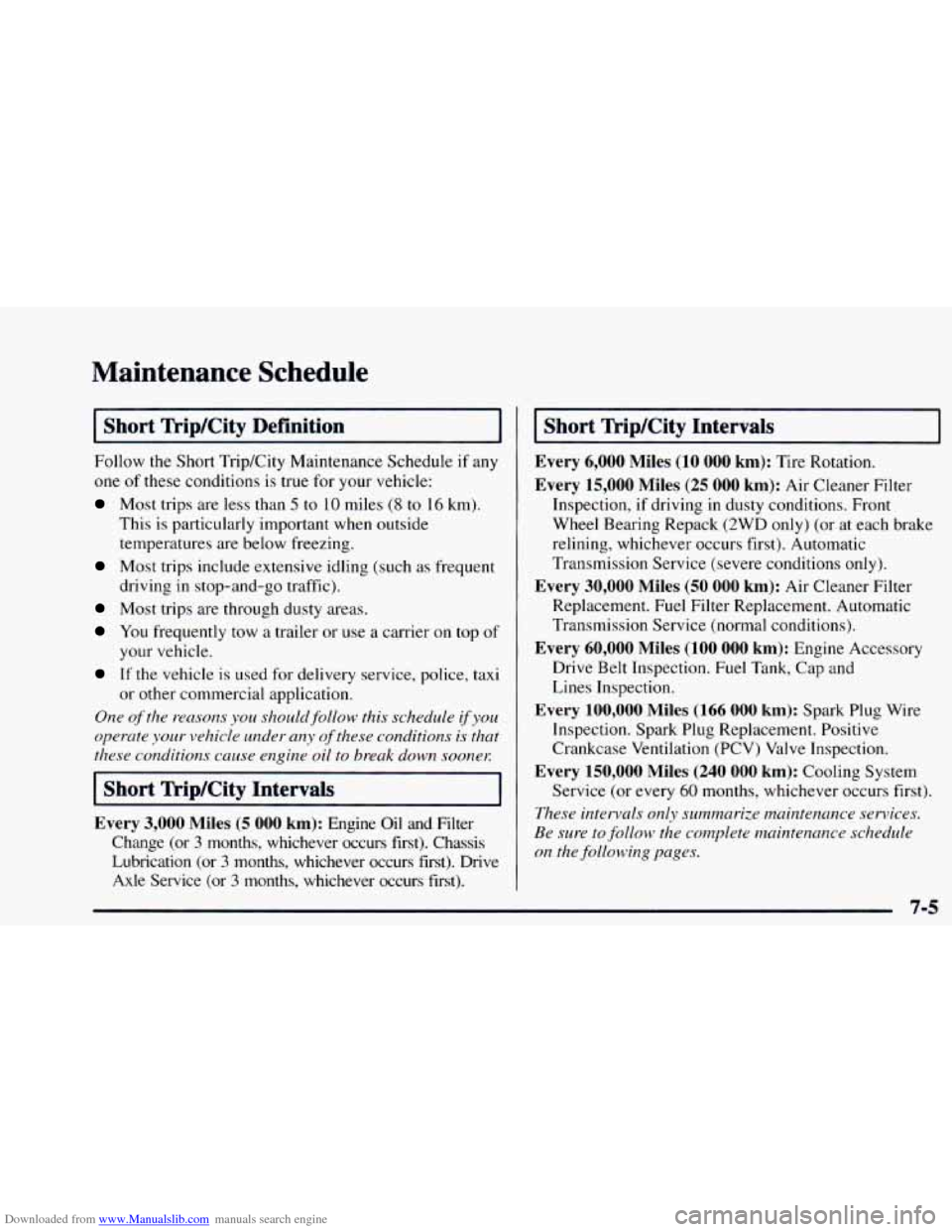
Downloaded from www.Manualslib.com manuals search engine Maintenance Schedule
Short Trip/City Definition
Follow the Short TripKity Maintenance Schedule if any
one of these conditions is true for your vehicle:
Most trips are less than 5 to 10 miles (8 to 16 km).
This is particularly important when outside
temperatures are below freezing.
Most trips include extensive idling (such as frequent
driving in stop-and-go traffic).
Most trips are through dusty areas.
You frequently tow a trailer or use a carrier on top of
If the vehicle is used for delivery service, police, taxi
One of the reasons ~OLI should,follow this schedule ifyou
operate your vehicle under any of these conditions is thnt
these conditions
cause engine oil to brenk down sooneK
your vehicle.
or other commercial application.
I
Short TripKity Intervals
Every 3,000 Miles (5 000 km): Engine Oil and Filter
Change (or
3 months, whichever occurs first). Chassis
Lubrication (or
3 months, whichever occurs first). Drive
Axle Service (or 3 months, whichever occurs first).
Short Trip/City Intervals -
Every 6,000 Miles (10 000 km): Tire Rotation.
Every 15,000 Miles (25 000 km): Air Cleaner Filter
Inspection, if driving in dusty conditions. Front
Wheel Bearing Repack (2WD only) (or at each brake
relining, whichever occurs first). Automatic
Transmission Service (severe conditions
only).
Every 30,000 Miles (50 000 km): Air Cleaner Filter
Replacement.
Fuel Filter Replacement. Automatic
Transmission Service (normal conditions).
Every 60,000 Miles (100 000 km): Engine Accessory
Drive Belt Inspection. Fuel Tank, Cap and
Lines Inspection.
Inspection. Spark Plug Replacement. Positive
Crankcase Ventilation (PCV) Valve Inspection.
Every 150,000 Miles (240 000 km): Cooling System
Service (or every
60 months, whichever occurs first).
These intervnls only sunznznrize muintenance services.
Be sure to follow the comnplete rnainterzance schedule
on the followkg pages.
Every 100,000 Miles (166 000 km): Spark Plug Wire
7-5
Page 330 of 404
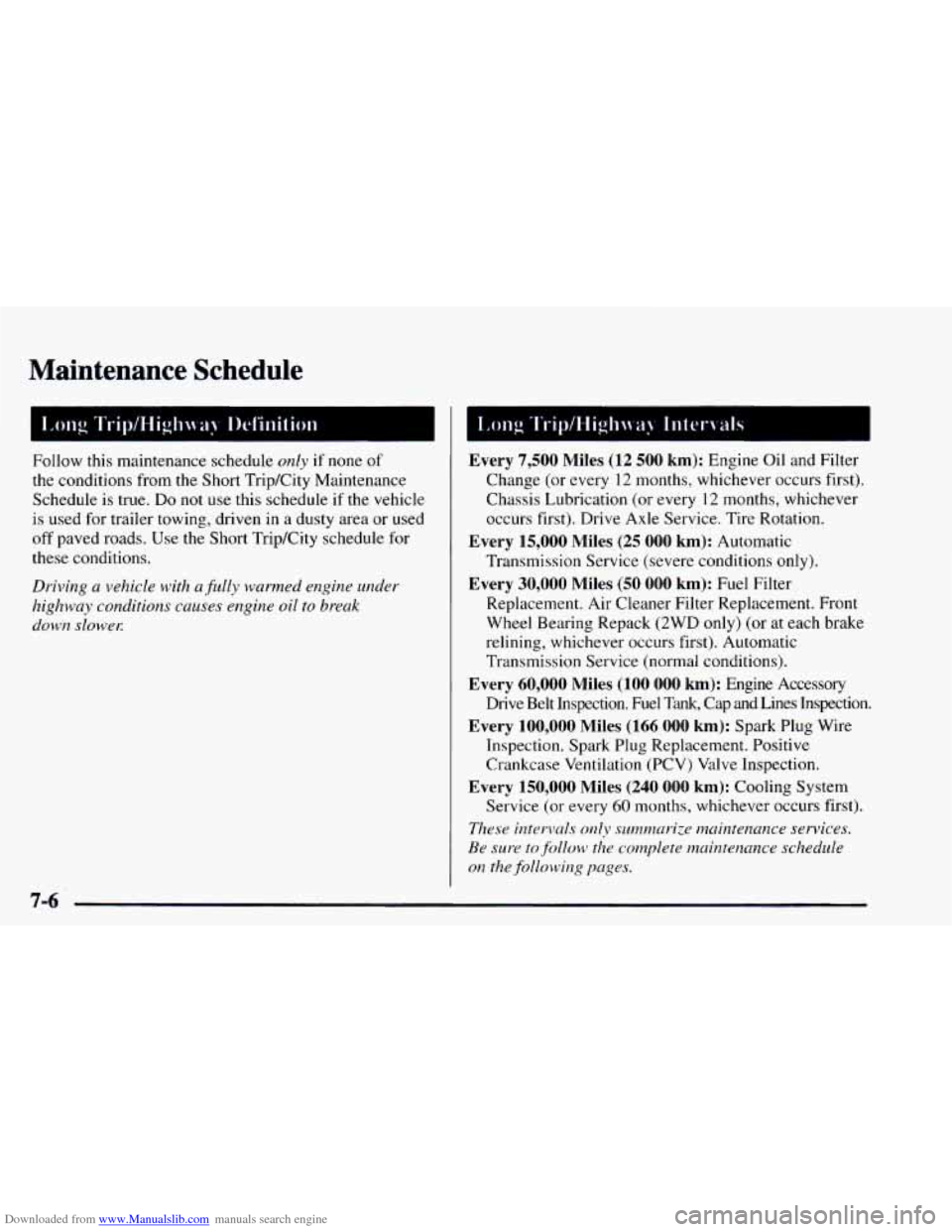
Downloaded from www.Manualslib.com manuals search engine Maintenance Schedule
Follow this maintenance schedule only if none of
the conditions from the Short TripKity Maintenance
Schedule is true.
Do not use this schedule if the vehicle
is used for trailer towing, driven in a dusty area or used
off paved roads. Use the Short TripKity schedule for
these conditions.
Driving a vehicle with a fully warmed engine under
highway conditions causes engine oil to break
down slower:
Every 7,500 Miles (12 500 km): Engine Oil and Filter
Change (or every
I2 months, whichever occurs first).
Chassis Lubrication (or every
12 months, whichever
occurs first). Drive Axle Service. Tire Rotation.
Transmission Service (severe conditions
only).
Replacement. Air Cleaner Filter Replacement. Front
Wheel Bearing Repack
(2WD only) (or at each brake
relining, whichever occurs first). Automatic
Transmission Service (normal conditions).
Drive Belt Inspection. Fuel Tank, Cap and Lines Inspection.
Inspection. Spark Plug Replacement. Positive
Crankcase Ventilation (PCV) Valve Inspection.
Every 150,000 Miles (240 000 km): Cooling System
Service (or every
60 months, whichever occurs first).
These intervals only summarize rncrintenance services.
Be sure
to follow the complete maintenance schedule
on the following pages.
Every 15,000 Miles (25 000 km): Automatic
Every 30,000 Miles (50 000 km): Fuel Filter
Every 60,000 Miles (100 000 km): Engine Accessory
Every 100,000 Miles (166 000 km): Spark Plug Wire
7-6